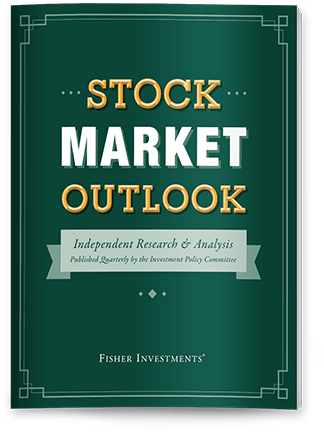Personal Wealth Management / Market Analysis
Shake the Valuation Fixation
Whatever their level and whichever flavor you prefer, price-to-earnings ratios say little about markets’ future direction.
In the wake of the S&P 500’s rebound to new highs following this spring’s correction, older fears are back: Now murmurs are surfacing arguing US stocks are now too expensive, with pundits suggesting elevated price-to-earnings ratios (P/Es) signal trouble ahead.[i] But hold on. Valuations aren’t a forecasting easy button. A sober review of history proves they tell you very little about where markets are headed.
As the abbreviation implies, P/E ratios divide an index’s (or stock’s) price by its components’ (or the company’s) earnings. This technically represents how much investors are willing to pay for each dollar of earnings, so a high ratio is theoretically a hefty price tag. So, with three common P/E variations—trailing, forward and the cyclically adjusted P/E (CAPE)—sitting well above their long-term averages, pundits warn “overvalued” stocks are poised to fall.[ii]
But all these various flavors have issues that ding their predictive power. Take the trailing P/E ratio, which divides today’s stock or index price by the company’s or indexes’ aggregate earnings over the past 12 months. Two things here: First, past earnings don’t affect future earnings, and stocks care primarily about how the latter squares with expectations. Second, stocks price in earnings 3 – 30 months ahead, so the past year’s earnings were incorporated into the numerator well before today’s calculation. It is backward looking through and through, sapping its predictive power.
Some look instead to forward P/Es, which compare prices to analysts’ consensus earnings estimates for the next 12 months. This approach is a bit more forward-looking conceptually, but it still has backward-looking aspects. Then, too, over the past five years, an average 77% of constituents beat consensus estimates, suggesting P/Es based on them will skew too high (from an excessively low denominator).[iii] Analysts’ expectations also tend to reflect prevailing sentiment. If dour, as after a correction, analysts tend to lower earnings estimates, potentially skewing the valuation even higher.
Last is CAPE. This gauge has some, umm, special quirks. CAPE was designed to foretell returns over a 10-year period—not cyclical shifts—by eliminating cyclical ups and downs (recessions and expansions) via comparing prices to the 10-year average of inflation-adjusted profits.
But that isn’t really how most users commonly talk about it, in our experience. The gauge rose to fame in late 1996, when then-Fed chair Alan Greenspan cited it as a sign of "irrational exuberance" in markets, popularizing the term and the measure. Markets rose the next three years, naturally. The gauge’s creators published a book on it in early 2000. And, coinciding with this, the Tech bubble burst. Many cast that correlation as a sign CAPE was the bees’ knees. To them, it “predicted” the bubble bursting, even though that isn’t what the gauge is designed to do.
CAPE has several critical flaws, in our view. For one, it uses old earnings to predict returns 10 years ahead. Not only are past returns nonpredictive, but most investors are focused on the much nearer term. Investors in 2001 would likely care far more about how markets moved cyclically in the next 10 years than the raw point-to-point return figure.
Therein lies the rub: Markets move in cycles—but this gauge intentionally obscures that. And in doing so, it adds a further variable: inflation. We can quibble up and down about which measure you use to deflate earnings, but however you do it, this gauge compares that to current prices, a mismatch. In our view, this all results in a broken indicator lacking any real predictive ability. Which makes sense, because stock returns are all about supply and demand for stocks. In the short run, demand dominates. Not so longer term, but nothing about a high or low CAPE really indicates much about 10-year supply trends in stock issuance or destruction.
Now, let us leave the theoretical behind and look at history. Exhibit 1 shows the long-term average P/E (since data start in 1926) plotted against trailing P/Es since 1996. (We shortened this to facilitate viewing the indexes’ wiggles and wobbles, which are hard to discern on long-term graphs.) Note how often valuations top the average recently—but stocks rose most of this span. And look at how crazy high they were in 2009—among history’s best buying opportunities. Why? Earnings were destroyed by the financial crisis. Backward-looking P/Es couldn’t foresee a recovery.
Exhibit 1: S&P 500 Vs. Trailing P/Es

Source: Multpl.com, as of 7/9/2025. S&P 500 price index and 12-month trailing P/E ratio, January 1996 – June 2025.
Exhibit 2 shows US stocks and their forward P/E ratio, with the average since 1996 due to data availability. This reveals a somewhat different issue.
Exhibit 2: S&P 500 vs Forward P/E

Source: FactSet, as of 7/9/2025. S&P 500 price index and 12-month forward P/E ratio, January 1996 – June 2025.
As this shows, forward P/Es have coincided with new bear and bull markets at varying levels and trends. Sure, the P/E was above-average and rising just before 2000 – 2002’s bear market, but it was below average and falling just before 2007 – 2009’s. It was just above its long-term average pre-2020 and, like the trailing P/E, falling ahead of 2022’s bear market. To us, this speaks to forward P/Es’ unreliability as an indicator.
Lastly, Exhibit 3 looks at CAPE’s history.
Exhibit 3: S&P vs CAPE

Source: Multpl.com, as of 7/9/2025. S&P 500 price index and Cyclically Adjusted P/E (CAPE) ratio, January 1996 – June 2025. Average shown is since 1926.
CAPE exceeded its long-term average at the beginning of the past four bear markets (despite ranging widely from 44.0 in 2000 to 25.7 in 2008). But it was also above average for the vast majority of the intervening bull markets. And again, CAPE was designed to project 10-year returns—not cyclical turning points. Look at the history since 2010. For all this span, CAPE was above average—often WAY above average. Yet overall returns have been great, with few periods even approaching below average 10-year returns. Even at its stated purpose, CAPE hasn’t been working.
There is simply no level or trend where P/E ratios reliably indicate an upcoming bear or bull market—no matter which method you choose.
If you would like to contact the editors responsible for this article, please message MarketMinder directly.
*The content contained in this article represents only the opinions and viewpoints of the Fisher Investments editorial staff.
Get a weekly roundup of our market insights
Sign up for our weekly e-mail newsletter.

You Imagine Your Future. We Help You Get There.
Are you ready to start your journey to a better financial future?

Where Might the Market Go Next?
Confidently tackle the market’s ups and downs with independent research and analysis that tells you where we think stocks are headed—and why.





